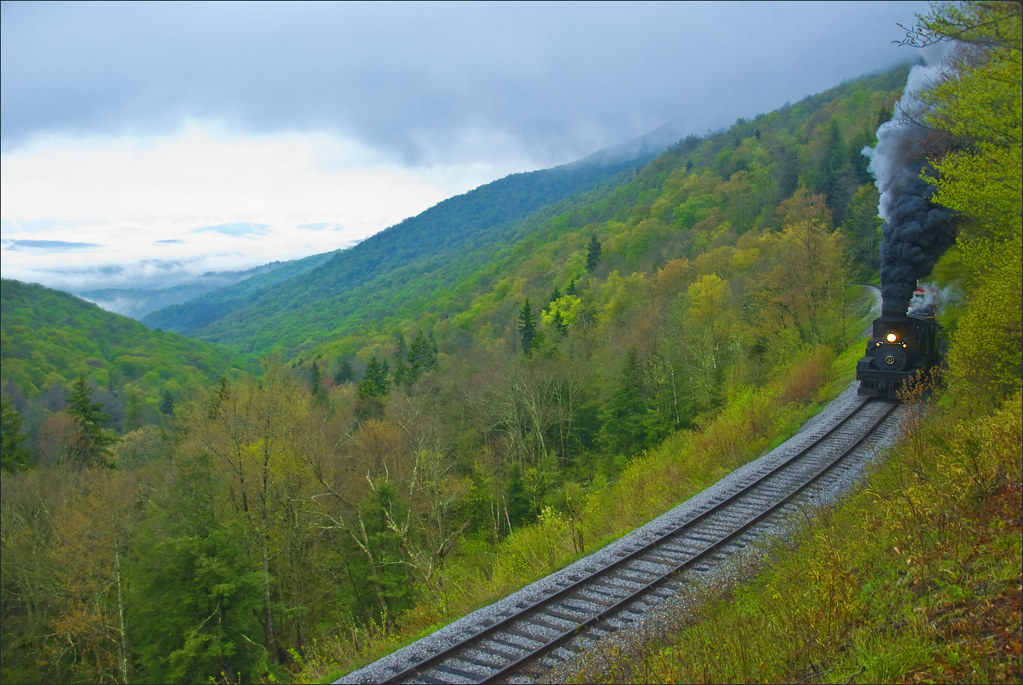
The Cass Scenic Railroad in West Virginia features a popular train observation spot known as Bald Knob. It is the third-highest point in the state, offering breathtaking panoramic views of the surrounding Appalachian Mountains. Visitors can enjoy the scenic beauty and diverse wildlife from this vantage point.
Photos
Sign in to upload photos
No Photos Yet
Be the first to share photos of this location!
Cass Scenic Railroad – Cass, West Virginia, USA | Train Spotting Location
Trainspotting Experience
A typical visit centers on the depot area in the preserved company town of Cass, where trains assemble beneath an antique wooden water tower. Railfans may watch crews oil side-rods and load water before departure, providing close-up mechanical views impossible on mainline operations. Once underway, the train crawls past the depot at roughly 5–10 mph, allowing extended photography and plenty of time to appreciate the syncopated “chug-chug-chug” produced by the Shay’s vertical pistons.
Two favored ground-level viewing points lie within a ¼-mile walk: the curved trestle over Leatherbark Creek, where engines work hard right after leaving town, and the first switchback, a dramatic location where the locomotive reverses direction on a steep 8 percent grade. Because speeds rarely exceed 15 mph, you can relocate between these spots without missing the consist. Expect trains of 6–8 open excursion coaches plus a combine, totaling about 250 ft in length. Auditory cues dominate: gears whine, whistles echo off the slopes, and the scent of coal smoke mixes with mountain air.
Landscape, Setting & Local Atmosphere
Cass sits at roughly 2,450 ft elevation in the Allegheny Mountains. The track quickly climbs toward Bald Knob, cresting just below 4,800 ft, so weather can shift from warm valley sun to cool, misty cloud within an hour. Dense hardwood forest cloaks the lower grades, giving way to red spruce and exposed rock near the summit. Autumn turns the hillsides into a patchwork of crimson and gold, while summer offers deep greens and clear mountain light. Aside from the occasional whistle, the setting is quiet; there is no through highway noise, only rushing streams and birdsong.
Type & Frequency of Train Activity
Operations are strictly heritage passenger. From late May through early November, the railroad typically runs two to four scheduled trains daily: shorter 4-mile trips to Whittaker Station (about 1 hour each way) and longer 11-mile climbs to Bald Knob (4½ hours round trip). During peak foliage weekends the schedule can expand to five departures. Motive power is almost always steam, with a roster that includes Shay locomotives Nos. 2, 4, 5, 6 and Heisler No. 6; diesel substitutes are extremely rare and normally limited to maintenance moves. Freight, intermodal, and Class I carriers do not operate here, so every train is a photo freight in appearance but a tourist passenger in fact.
Best Angles for Photos & What Railfans Enjoy Most
• Depot platform: Morning light illuminates the engineer’s side, highlighting valve gear as crews prepare.
• Leatherbark Creek trestle: A ¾ front view captures the engine on the bridge with forested hills as backdrop; mid-afternoon sun lights the scene.
• First switchback: Position on the embankment above the tail track for an overhead shot of the locomotive pushing uphill and again pulling forward—a two-for-one sequence.
• Whittaker Station: Restored bunkhouse cars, a water crane, and wide clearings allow full-train panoramas at midday.
• Bald Knob overlook: Photographs here frame the train against sweeping vistas into the Greenbrier Valley 2,000 ft below; late afternoon yields warm side lighting.
Low speeds let photographers experiment with panning or dramatic steam plumes without motion blur. Many railfans cherish night sessions during special events when locomotives are staged under floodlights against star-filled skies.
Historical or Cultural Relevance
The line was built in 1901 by the West Virginia Pulp & Paper Company to haul white pine and red spruce from Cheat Mountain to the mill in Cass. Its 8 percent grades demanded geared locomotives, and the railroad eventually rostered the largest fleet of Shays in the eastern United States. Commercial logging ceased in 1960; concerned locals and rail enthusiasts secured state protection, leading to the creation of Cass Scenic Railroad State Park in 1963—one of America’s earliest rail-heritage preserves. The surrounding town remains largely intact: company houses, the former mill site, and a small historical museum illustrate life in an early 20th-century logging camp.
What Makes This Spot Different
Unlike many heritage lines that operate short demonstration runs on level track, Cass offers sustained, authentic mountain railroading on its original route, complete with switchbacks, steep grades, and period-correct geared power. The combination of close-up accessibility, unspoiled natural setting, and mechanical rarity means every visit delivers sights, sounds, and scents most trainspotters have only read about. Where else can you stand beside a 1905 Shay, feel the ground vibrate as it claws uphill, then follow it to a 4,700-ft summit—all in the same afternoon?
Seasonal Information
For Cass Scenic Railroad's Bald Knob in West Virginia, the best seasons are spring and fall for mild weather and vibrant scenery. Summer offers lush greenery, while winter provides snowy landscapes. Check for special excursions and prepare for varying weather conditions.
Other Interesting Locations
Looking for more spots? Browse the complete list of train spotting locations.
Quick Information
Country
USA
Region / State / Province
West Virginia
City
Cass
Spot Type
Scenic Overlook
Best Times
Best hours to observe trains at Cass Scenic Railroad: mid-morning to early afternoon for clear views and optimal lighting. Check train schedules for specific departure times.
